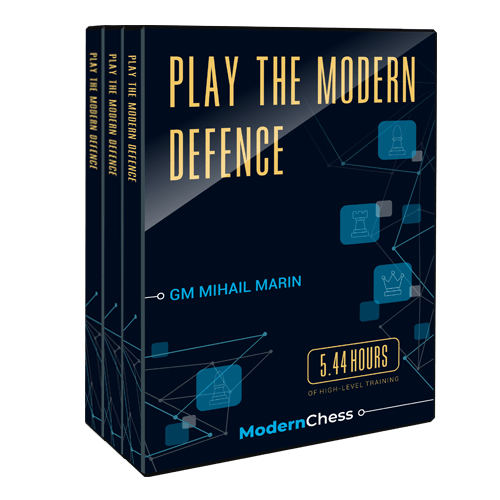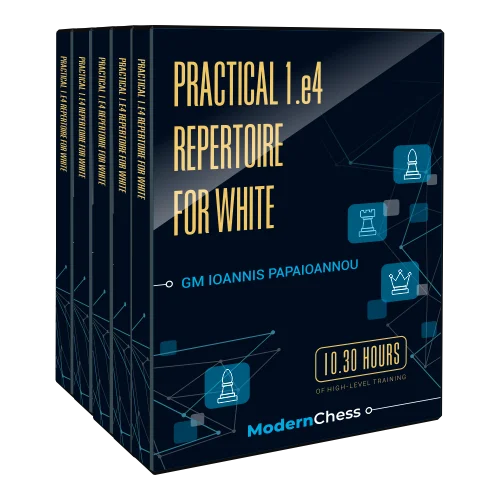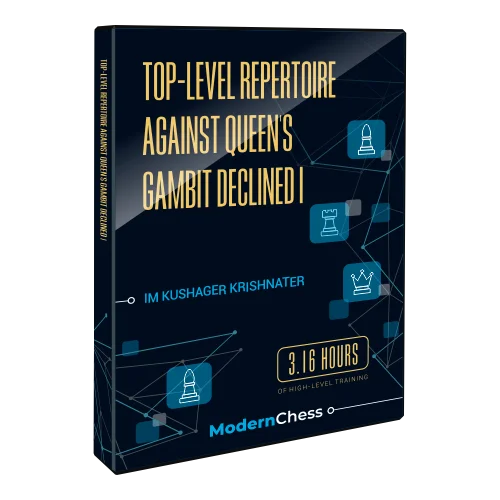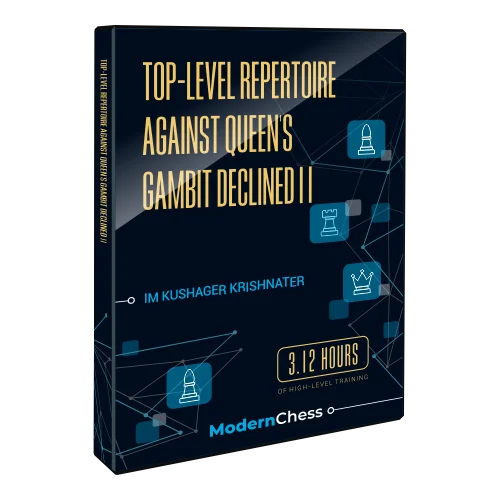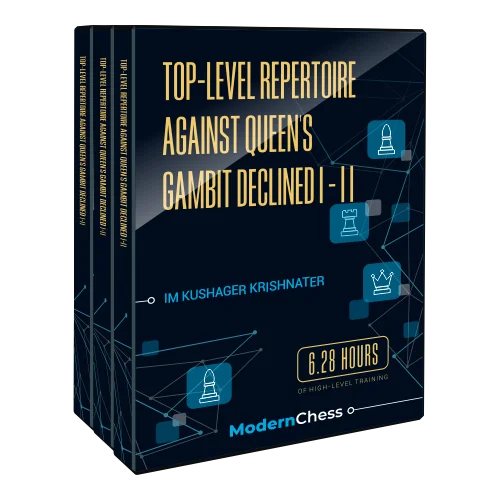We are happy to introduce the new opening project of GM Mihail Marin - Play the Modern Defence. After a long period of analysis and research, Marin is finally able to provide you with a universal repertoire that you can use both against 1.e4 and 1.d4. Besides being a highly practical choice, the Modern Defence lies on solid positional foundations. True to the hyper modernist understanding, Black constantly tries to undermine White's center. Since the strategic imbalance is created at the very beginning, this is a perfect opening for everyone who wants to play for a win with Black.
We are happy to introduce the new opening project of GM Mihail Marin – Play the Modern Defence. After a long period of analysis and research, Marin is finally able to provide you with a universal repertoire that you can use both against 1.e4 and 1.d4. Besides being a highly practical choice, the Modern Defence lies on solid positional foundations. True to the hyper modernist understanding, Black constantly tries to undermine White’s center. Since the strategic imbalance is created at the very beginning, this is a perfect opening for everyone who wants to play for a win with Black.
The current database includes 64 theoretical chapters, 15 interactive test positions, Video Version (5h 40min Running Time), and Memory Booster.
Preview by the Author:
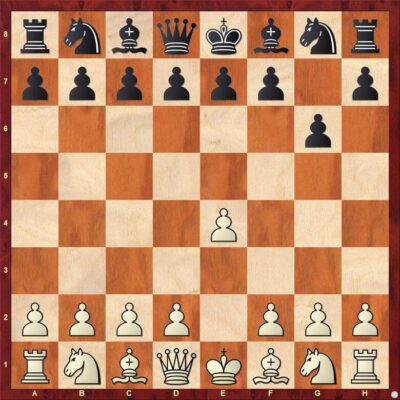
I wonder why it did not occur to me earlier that Modern Chess needs a database on the … Modern Defence! Joke left aside, the Modern Defence is not that young. The obscure (but rather strong) Indian player Mohishunder Bonnerjee repeatedly played 1…g6 around 1850 against the better known John Cochrane. The two have played many hundreds of games in that period. However, play usually transposed from the Modern to the King’s Indian Defence, rightly called by the Soviet magazines “The Old Indian”. It is an old opening invented by an Indian, is it not? There were times when the Modern Defence was also named the Robatch defence. The Austrian grandmaster frequently employed it with the black pieces.
Adding to what I wrote above, I did not neglect the move order 1.d4 g6 2.c4 Bg7, when White can play without e2-e4. This way, we get a repertoire against both 1.e4 and 1.d4. (Lines 12 to 15).
Until now, my relationship with the Modern/Robatsch Defence has been rather platonic. For many years I have played the Pirc defence: 1.e4 d6 2.d4 Nf6 3.Nc3 g6, with pretty good results.
Over the past few years, I have written a book and recorded two video DVDs about it. However, I could not avoid the feeling that in some lines Black is a bit on the edge, needing to remember long forced lines and being exposed to a forced draw sometimes. I considered the possibility of using the Robatsch move order in order to sidestep some of the dangers, but my main problem was what if White plays 3.c4? The irony is that I have played the King’s Indian in several periods of my life, but never at the same time with the Pirc Defence!! When working for this (not small) database, I was glad to find out that even if White plays 3.c4, Black can avoid transposing to the King’s Indian and retain good play anyway. This way, the repertoire proposed to the reader is, as much as this is possible, complete. Why did I make that remark?
Given the huge transpositional possibilities, there might always be some tiny line that escapes the author’s attention. However, I am confident that I have examined all the important systems and variations. One specification is needed, though. I have not examined systems such as the London attack (Is it an attack?! If so, isn’t it the Carlos Torre Attack?!) or the Closed Sicilian, to which White could more or less force a transposition. I am confident that these can be found in other databases. If not, I may fill this gap.
The first important crossroads arises after 2.d4 Bg7

I also cover 2.h4 and 2.f4 in the database.
On the diagram position, White’s most popular move is 3.Nc3. This is the typical anti-Pirc setup. White opts for rapid development, leaving strategic factors in the background. You know… these 1.e4 players, they do not care much about their c2-pawn, but try to mate you as soon as possible!
The move 3.c3 is strategically consistent but a bit slow. See Lines 16 to 23.
After 3.c4, we get the so-called Averbakh System. Do not ask me why. Averbakh played it fewer times than Cochrane against his Indian sparring partner.
Rather tricky move order is 3.Nf3 maintaining the possibility of choosing either a Pirc or a King’s Indian setup. However, the last move discards almost all the aggressive Pirc systems, allowing Black to transpose to this opening with 3…d6 followed by .. .Nf6. My main line goes 3…d6 4.Be2 (4.Be3 Nf6 5.Nc3 is another such system. See Lines 58 to 60.) 4…Nf6 5.Nc3 0-0 6.0-0 a6!? We have transposed to the classical Pirc, covered in Lines 53 to 56.
Another major branching point arises after 3.Nc3 d6
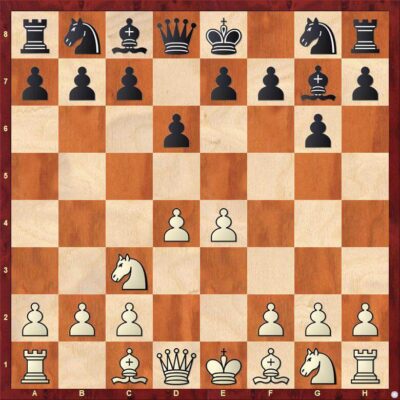
Now, White’s most aggressive approach is 4.f4 when we reach the so-called Austrian Attack.
Against the Pirc Defence, 4.Bg5 is dangerous, too, but less effective with the Modern move order. See Lines 29 to 32.
To a certain extent, the same applies to 4.Be3, examined in Lines 33 to 35.
4.Nf3 a6 can lead to a series of systems, most of them positional, in which Black usually obtains good queenside counterplay. These are the subject of Lines 41 to 50, including the Classical Pirc, mentioned elsewhere in this tree, too.
In the line with 4.f4, the critical position arises after 4…a6 5.Nf3 b5
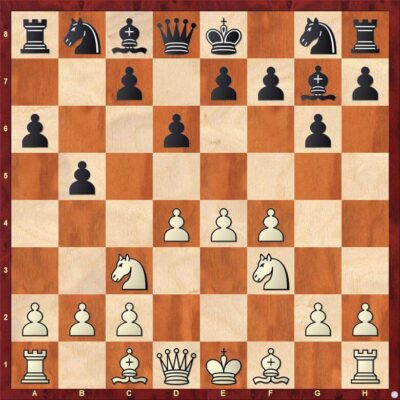
Black’s play surely is provocative, but the good thing is that he can mainly use his intuition and dynamic skills (with just a few not too long variations to remember). Play is very complicated and White can also be at risk, which is a common feature of most of the lines examined in this database. See Lines 24 to 28. I plan to make the Modern Defence my universal opening for a while.
Whether I will sometimes transpose to the Pirc Defence or the King’s Indian, I cannot say yet. I wish to get a better perception of this very complex opening and maybe my experience will result in periodical updates of this database. I had not planned it this way, but the database contains 64 lines. I hope that this will be a good luck charm coincidence.
Outline:
Line 1 3.c4 – 4.Nc3 e5 5.Nf3 Bg4
Line 2 3.c4 – 4.Nc3 e5 5.Nf3 Bg4 6.dxe5
Line 3 3.c4 – 8.Ng5
Line 4 3.c4 – 8.Be3
Line 5 3.c4 – 4.Nc3 e5 5.d5
Line 6 3.c4 – 4.Nc3 e5 5.dxe5 dxe5
Line 7 3.c4 – 4.Nc3 e5 5.Nge2
Line 8 3.c4 – 4.Nc3 e5 5.Nge2 Nc6 6.Be3
Line 9 3.c4 – 4.Nc3 e5 5.Nge2 Nc6 6.Be3
Line 10 3.c4 – 4.Nc3 e5 5.Be3
Line 11 3.c4 – Various
Line 12 1.d4 – 3.Nf3 4.Nc3
Line 13 1.d4 – 3.Nf3 4.g3
Line 14 1.d4 – 4.g3 8.e4
Line 15 1.d4 – 3.g3 10.Nde2
Line 16 3.c3 – 4.f4
Line 17 3.c3 – 4.f4 7.dxc5
Line 18 3.c3 – 4.Nf3 5.Nbd2
Line 19 3.c3 – 4.Nf3 5.Bd3
Line 20 3.c3 – 4.Nf3 7.Bg5
Line 21 3.c3 – 4.Nf3 7.Re1
Line 22 3.c3 – 4.Nf3 8.h3
Line 23 3.c3 – 4.Nf3 9.Be3
Line 24 3.Nc3 – 4.f4
Line 25 3.Nc3 – 4.f4 7.a4
Line 26 3.Nc3 – 4.f4 7.e5
Line 27 3.Nc3 – 4.f4 8.Be4
Line 28 3.Nc3 – 4.f4 8.Be4 17.Qd5
Line 29 3.Nc3 – 4.Bg5
Line 30 3.Nc3 – 4.Bg5 5.f4
Line 31 3.Nc3 – 4.Bg5 5.Qd2
Line 32 3.Nc3 – 4.Bg5 6.a4
Line 33 4.Nc3 – 4.Be3
Line 34 3.Nc3 – 4.Be3 6.h4
Line 35 3.Nc3 – 4.Be3 6.f3
Line 36 3.Nc3 – 4.Bf4
Line 37 3.Nc3 – 4.g3
Line 38 3.Nc3 – 4.g3 5.d5
Line 39 3.Nc3 – 4.g3 5.Be3
Line 40 3.Nc3 – 4.h4 4.g4
Line 41 3.Nc3 d6 4.Nf3 – 5.a4
Line 42 3.Nc3 d6 – 5.a4 6.Be2
Line 43 3.Nc3 d6 – 5.a4 8.dxe5
Line 44 3.Nc3 d6 – 5.a4 9.Nd5
Line 45 3.Nc3 d6 – 5.Bc4
Line 46 3.Nc3 d6 4.Nf3 – 5.Be3
Line 47 3.Nc3 d6 4.Nf3 – 5.Be3 6.e5
Line 48 3.Nc3 d6 4.Nf3 – 5.Be3 6.Bd3
Line 49 3.Nc3 d6 4.Nf3 – 5.Be3 6.Bd3 7.0-0 8.Qd2
Line 50 3.Nc3 d6 4.Nf3 – 5.Be3 6.Bd3 8.Ne2
Line 51 3.Nc3 d6 – 5.Be3 8.a4
Line 52 3.Nc3 d6 – 5.Be3 9.Ne2
Line 53 3.Nc3 – 4.Nf3 5.Be2
Line 54 3.Nc3 – 4.Nf3 5.Be2
Line 55 3.Nc3 – 4.Nf3 5.Be2 7.h3
Line 56 3.Nc3 – 4.Nf3 5.Be2 7.Re1
Line 57 3.Bc4 and 4.Bc4
Line 58 3.Nf3 – 4.Be3
Line 59 3.Nf3 – 4.Be3 6.Qd2
Line 60 3.Nf3 – 4.Be3 7.Bh6
Line 61 3.f4
Line 62 3.various
Line 63 2.f4
Line 64 2.h4
Test Section
About the Author:
GM Mihail Marin [FIDE 2463]
is a Romanian chess Grandmaster and a very popular chess coach and author. Marin’s first major success in international chess was qualifying for the Interzonal in 1987.
He has won the Romanian Championships on three occasions and has played in the Chess Olympiads ten times, winning a bronze individual medal in 1988. For several years he was the editor of the magazine Chess Extra press.
GM Mihail Marin is one of the most respected coaches in the world today having trained the young Judit Polgar and being praised for his ability to explain deep chess truths in a way improving players can understand.
